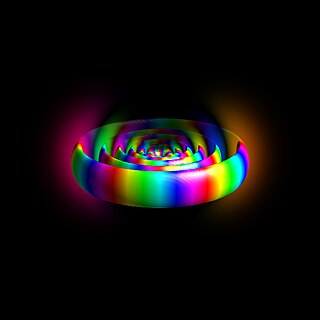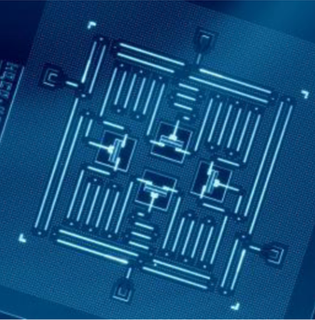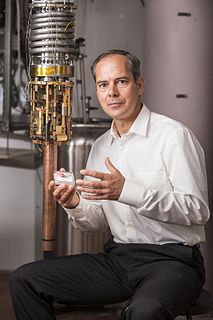Related Research Articles

Quantum mechanics is a fundamental theory in physics that provides a description of the physical properties of nature at the scale of atoms and subatomic particles. It is the foundation of all quantum physics including quantum chemistry, quantum field theory, quantum technology, and quantum information science.
In physics, statistical mechanics is a mathematical framework that applies statistical methods and probability theory to large assemblies of microscopic entities. It does not assume or postulate any natural laws, but explains the macroscopic behavior of nature from the behavior of such ensembles.

Newton's laws of motion are three basic laws of classical mechanics that describe the relationship between the motion of an object and the forces acting on it. These laws can be paraphrased as follows:
- A body remains at rest, or in motion at a constant speed in a straight line, unless acted upon by a force.
- When a body is acted upon by a force, the time rate of change of its momentum equals the force.
- If two bodies exert forces on each other, these forces have the same magnitude but opposite directions.
In physics, the correspondence principle states that the behavior of systems described by the theory of quantum mechanics reproduces classical physics in the limit of large quantum numbers. In other words, it says that for large orbits and for large energies, quantum calculations must agree with classical calculations.
The macroscopic scale is the length scale on which objects or phenomena are large enough to be visible with the naked eye, without magnifying optical instruments. It is the opposite of microscopic.
In quantum mechanics, the measurement problem is the problem of how, or whether, wave function collapse occurs. The inability to observe such a collapse directly has given rise to different interpretations of quantum mechanics and poses a key set of questions that each interpretation must answer.
A Bell test, also known as Bell inequality test or Bell experiment, is a real-world physics experiment designed to test the theory of quantum mechanics in relation to Albert Einstein's concept of local realism. The experiments test whether or not the real world satisfies local realism, which requires the presence of some additional local variables to explain the behavior of particles like photons and electrons. To date, all Bell tests have found that the hypothesis of local hidden variables is inconsistent with the way that physical systems behave.

A Rydberg atom is an excited atom with one or more electrons that have a very high principal quantum number, n. The higher the value of n, the farther the electron is from the nucleus, on average. Rydberg atoms have a number of peculiar properties including an exaggerated response to electric and magnetic fields, long decay periods and electron wavefunctions that approximate, under some conditions, classical orbits of electrons about the nuclei. The core electrons shield the outer electron from the electric field of the nucleus such that, from a distance, the electric potential looks identical to that experienced by the electron in a hydrogen atom.

Superconducting quantum computing implements quantum computing with superconducting electronic circuits. Research in superconducting quantum computing is conducted by companies such as Google, IBM, IMEC, BBN Technologies, Rigetti, and Intel. As of May 2016, up to nine fully controllable qubits are demonstrated in a 1D array, and up to sixteen in a 2D architecture.

An optical microcavity or microresonator is a structure formed by reflecting faces on the two sides of a spacer layer or optical medium, or by wrapping a waveguide in a circular fashion to form a ring. The former type is a standing wave cavity, and the latter is a traveling wave cavity. The name microcavity stems from the fact that it is often only a few micrometers thick, the spacer layer sometimes even in the nanometer range. As with common lasers, this forms an optical cavity or optical resonator, allowing a standing wave to form inside the spacer layer or a traveling wave that goes around in the ring.
A quantum gyroscope is a very sensitive device to measure angular rotation based on quantum mechanical principles. The first of these was built by Richard Packard and his colleagues at the University of California, Berkeley. The extreme sensitivity means that theoretically, a larger version could detect effects like minute changes in the rotational rate of the Earth.

The Intelligence Advanced Research Projects Activity (IARPA) is an organization within the Office of the Director of National Intelligence responsible for leading research to overcome difficult challenges relevant to the United States Intelligence Community. IARPA characterizes its mission as follows: "To envision and lead high-risk, high-payoff research that delivers innovative technology for future overwhelming intelligence advantage."

Dirk (Dik) Bouwmeester is a Dutch experimental physicist specializing in quantum optics and quantum information. He currently holds faculty positions at the University of California at Santa Barbara and at Leiden University in the Netherlands.

Michael Lee Roukes is an American experimental physicist, nanoscientist, and the Frank J. Roshek Professor of Physics, Applied Physics, and Bioengineering at the California Institute of Technology (Caltech).

A quantum machine is a human-made device whose collective motion follows the laws of quantum mechanics. The idea that macroscopic objects may follow the laws of quantum mechanics dates back to the advent of quantum mechanics in the early 20th century. However, as highlighted by the Schrödinger's cat thought experiment, quantum effects are not readily observable in large-scale objects. Consequently, quantum states of motion have only been observed in special circumstances at extremely low temperatures. The fragility of quantum effects in macroscopic objects may arise from rapid quantum decoherence. Researchers created the first quantum machine in 2009, and the achievement was named the "Breakthrough of the Year" by Science in 2010.

Aaron Douglas O'Connell is an American experimental quantum physicist.
Macroscopic quantum phenomena are processes showing quantum behavior at the macroscopic scale, rather than at the atomic scale where quantum effects are prevalent. The best-known examples of macroscopic quantum phenomena are superfluidity and superconductivity; other examples include the quantum Hall effect and topological order. Since 2000 there has been extensive experimental work on quantum gases, particularly Bose–Einstein condensates.

Cavity optomechanics is a branch of physics which focuses on the interaction between light and mechanical objects on low-energy scales. It is a cross field of optics, quantum optics, solid-state physics and materials science. The motivation for research on cavity optomechanics comes from fundamental effects of quantum theory and gravity, as well as technological applications.
Nature's 10 is an annual listicle of ten "people who mattered" in science, produced by the scientific journal Nature. Nominees have made a significant impact in science either for good or for bad. Reporters and editorial staff at Nature judge nominees to have had "a significant impact on the world, or their position in the world may have had an important impact on science". Short biographical profiles describe the people behind some of the year's most important discoveries and events. Alongside the ten, five "ones to watch" for the following year are also listed.

Max Born was a widely influential German physicist and mathematician who was awarded the 1954 Nobel Prize in Physics for his pivotal role in the development of quantum mechanics. Born won the prize primarily for his contributions to the statistical interpretation of the wave function, though he is known for his work in several areas of quantum mechanics as well as solid-state physics, optics, and special relativity. Born's entry in the Biographical Memoirs of Fellows of the Royal Society included thirty books and 330 papers.
References
- ↑ O'Connell, A. D.; Hofheinz, M.; Ansmann, M.; Bialczak, Radoslaw C.; Lenander, M.; Lucero, Erik; Neeley, M.; Sank, D.; Wang, H.; Weides, M.; Wenner, J.; Martinis, John M.; Cleland, A. N. (2010). "Quantum ground state and single-phonon control of a mechanical resonator". Nature. 464 (7289): 697–703. Bibcode:2010Natur.464..697O. doi:10.1038/nature08967. ISSN 0028-0836. PMID 20237473. S2CID 4412475.
- ↑ Ansmann, Markus; Wang, H.; Bialczak, Radoslaw C.; Hofheinz, Max; Lucero, Erik; Neeley, M.; O'Connell, A. D.; Sank, D.; Weides, M.; Wenner, J.; Cleland, A. N.; Martinis, John M. (2009). "Violation of Bell's inequality in Josephson phase qubits". Nature. 461 (7263): 504–506. Bibcode:2009Natur.461..504A. doi:10.1038/nature08363. ISSN 0028-0836. PMID 19779447. S2CID 4401494.
- ↑ Jaeger, Gregg (September 2014). "What in the (quantum) world is macroscopic?". American Journal of Physics. 82 (9): 896–905. Bibcode:2014AmJPh..82..896J. doi:10.1119/1.4878358.
- ↑ Jaeger, Gregg (September 2014). "What in the (quantum) world is macroscopic?". American Journal of Physics. 82 (9): 896–905. Bibcode:2014AmJPh..82..896J. doi:10.1119/1.4878358.